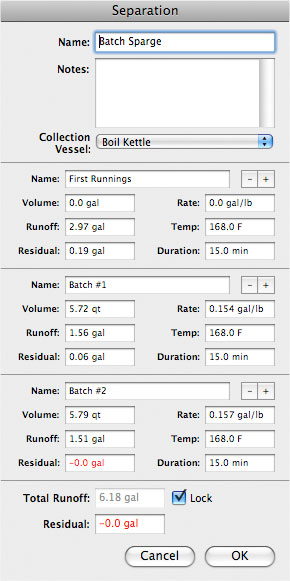Separation: Difference between revisions
Jump to navigation
Jump to search
mNo edit summary |
(→Editor) |
||
| (2 intermediate revisions by 2 users not shown) | |||
| Line 1: | Line 1: | ||
Separating the sweet wort from the grain husk material and other solids is done using processes such as [[Fly sparge|Fly Sparging]] and [[Batch sparge|Batch Sparging]]. The separation editor is used to set up sparging procedures in the schedule. | Separating the sweet wort from the grain husk material and other solids is done using processes such as [[Fly sparge|Fly Sparging]] and [[Batch sparge|Batch Sparging]]. The separation editor is used to set up sparging procedures in the schedule. | ||
{{example}} | |||
==Editor== | ==Editor== | ||
| Line 26: | Line 26: | ||
;Sparge Residual | ;Sparge Residual | ||
:The volume of runoff still available taking into account vessel dead space and grain absorption. | :The volume of runoff still available taking into account vessel dead space and grain absorption. | ||
;Sparge Infusion Rate | |||
:Rate of water volume to mass of grist for each sparge procedure. | |||
;Sparge Temperature | |||
:Temperature of the water added in each sparge procedure. | |||
;Sparge Duration | |||
:Length of time to complete each sparge procedure. | |||
;Total Runoff | ;Total Runoff | ||
Latest revision as of 17:11, 31 March 2008
Separating the sweet wort from the grain husk material and other solids is done using processes such as Fly Sparging and Batch Sparging. The separation editor is used to set up sparging procedures in the schedule.
Editor
The various fields in the "Separation" edit box are used for the following purposes:
|
